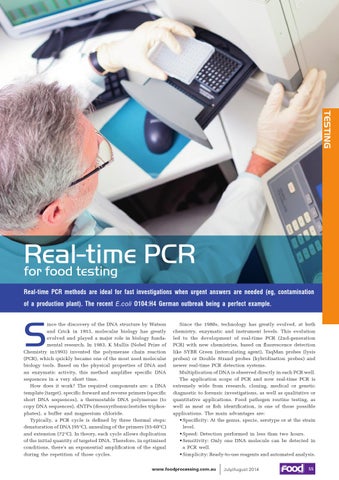/D
sto
©
ka
o
o Ph
Real-time PCR for food testing Real-time PCR methods are ideal for fast investigations when urgent answers are needed (eg, contamination of a production plant). The recent E.coli O104:H4 German outbreak being a perfect example.
S
ince the discovery of the DNA structure by Watson and Crick in 1953, molecular biology has greatly evolved and played a major role in biology fundamental research. In 1983, K Mullis (Nobel Prize of Chemistry in1993) invented the polymerase chain reaction (PCR), which quickly became one of the most used molecular biology tools. Based on the physical properties of DNA and an enzymatic activity, this method amplifies specific DNA sequences in a very short time. How does it work? The required components are: a DNA template (target), specific forward and reverse primers (specific short DNA sequences), a thermostable DNA polymerase (to copy DNA sequences), dNTPs (desoxyribonucleotides triphosphates), a buffer and magnesium chloride. Typically, a PCR cycle is defined by three thermal steps: denaturation of DNA (95°C), annealing of the primers (55-60°C) and extension (72°C). In theory, each cycle allows duplication of the initial quantity of targeted DNA. Therefore, in optimised conditions, there’s an exponential amplification of the signal during the repetition of those cycles.
Since the 1980s, technology has greatly evolved, at both chemistry, enzymatic and instrument levels. This evolution led to the development of real-time PCR (2nd-generation PCR) with new chemistries, based on fluorescence detection like SYBR Green (intercalating agent), TaqMan probes (lysis probes) or Double Strand probes (hybridisation probes) and newer real-time PCR detection systems. Multiplication of DNA is observed directly in each PCR well. The application scope of PCR and now real-time PCR is extremely wide from research, cloning, medical or genetic diagnostic to forensic investigations, as well as qualitative or quantitative applications. Food pathogen routine testing, as well as meat or fish identification, is one of those possible applications. The main advantages are: • Specificity: At the genus, specie, serotype or at the strain level. • Speed: Detection performed in less than two hours. • Sensitivity: Only one DNA molecule can be detected in a PCR well. • Simplicity: Ready-to-use reagents and automated analysis.
www.foodprocessing.com.au
July/August 2014
55
TESTING
lub
C to
r lla
